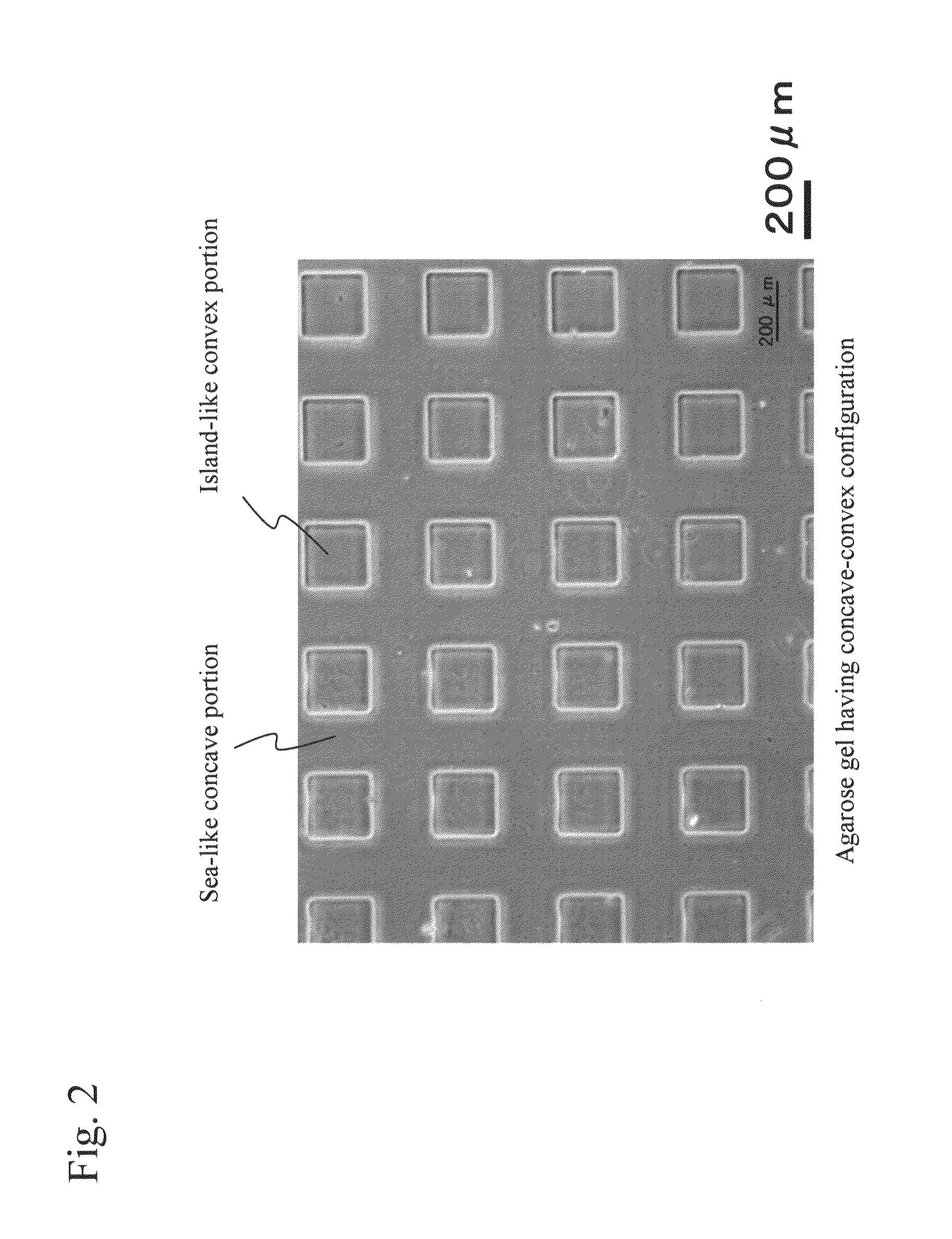Method for preparing biological tissue
a biological tissue and tissue technology, applied in the field of biological tissue preparation, can solve the problems of difficult handling, high cell density of biological tissue, and existing methods for preparing biological tissue with high cell density
- Summary
- Abstract
- Description
- Claims
- Application Information
AI Technical Summary
Benefits of technology
Problems solved by technology
Method used
Image
Examples
reference example 1
1. Preparation of Cell Sheet with Centrifugal Force
1-1. Preparation and Collection of Cell Sheet with Centrifugal Force
[0087]Polyethylene glycol was chemically applied to the entire inner surface of a glass vessel having a bottom with a diameter of 2 cm to render the entire inner surface non-cell-adhesive, 2 ml of a cell suspension containing 4×106 mouse fibroblasts suspended in 10% fetal bovine serum-containing DMEM medium was sowed in the vessel, and culture was conducted at 37° C. in the presence of 5% CO2 for 3 hours while applying centrifugal force of 720 G toward the bottom (FIG. 7A). After culture, centrifugation was terminated, and a cell sheet was easily and rapidly detached and collected from the substrate without destruction of the tissue structure by a physical force, such as via pipetting (FIG. 7B). As a contrast, culture was conducted in the same manner, except that no centrifugal force was applied. As a result, a cell sheet could not be prepared, cells were detached f...
reference example 2
2. Addition of Extracellular Matrix
2-1. Preparation of Extracellular Matrix-Containing Solution
[0089]DMEM medium containing 10% fetal bovine serum was added to a 10-cm polystyrene petri dish to culture mouse fibroblasts, and the cells were grown to reach confluence in order to have the cells to produce an extracellular matrix. Subsequently, multiplied cells were ground using a cell scraper, the cells were completely fragmented via ultrasound treatment, the fragmented product was centrifuged, and the supernatant was collected. The supernatant was used below as an extracellular matrix-containing solution.
2-2. Preparation and Collection of Cell Sheet with Centrifugal Force
[0090]Polyethylene glycol was chemically applied to the entire inner surface of a glass vessel having a bottom with a diameter of 2 cm to render the entire inner surface non-cell-adhesive, 2 ml of a cell suspension containing 4×106 mouse fibroblasts suspended in the extracellular matrix-containing solution prepared in...
example 1
3. Preparation of Cell Sheet Having Holes
3-1. Culture Vessel Having Non-Cell-Adhesive Bottom Surface with Concave-Convex Configuration
[0091]A silicon wafer was coated with resist (tradename: SU-8; manufacturer: MicroChem) to a thickness of 200 μm, a concave-convex template was prepared via optical lithography, a 3% agarose solution was introduced onto the template for gelation, and the resulting gel was detached from the template. Thus, agarose gel having a concave-convex pattern (200 μm×200 μm squares raised at heights of 200 μm at intervals of 200 μm) was prepared. FIG. 2 shows the concave-convex pattern of the prepared agarose gel. The resulting gel was positioned at the bottom of the vessel, with the entire inner bottom surface being made non-cell-adhesive in 1-1, so that the concave-convex surface of the gel would face upward. Thus, a culture vessel having a non-cell-adhesive and concave-convex bottom surface was prepared (FIG. 11).
3-2. Preparation of Extracellular Matrix-Conta...
PUM
| Property | Measurement | Unit |
|---|---|---|
| water contact angle | aaaaa | aaaaa |
| static water contact angle | aaaaa | aaaaa |
| thickness | aaaaa | aaaaa |
Abstract
Description
Claims
Application Information
 Login to View More
Login to View More - R&D
- Intellectual Property
- Life Sciences
- Materials
- Tech Scout
- Unparalleled Data Quality
- Higher Quality Content
- 60% Fewer Hallucinations
Browse by: Latest US Patents, China's latest patents, Technical Efficacy Thesaurus, Application Domain, Technology Topic, Popular Technical Reports.
© 2025 PatSnap. All rights reserved.Legal|Privacy policy|Modern Slavery Act Transparency Statement|Sitemap|About US| Contact US: help@patsnap.com



